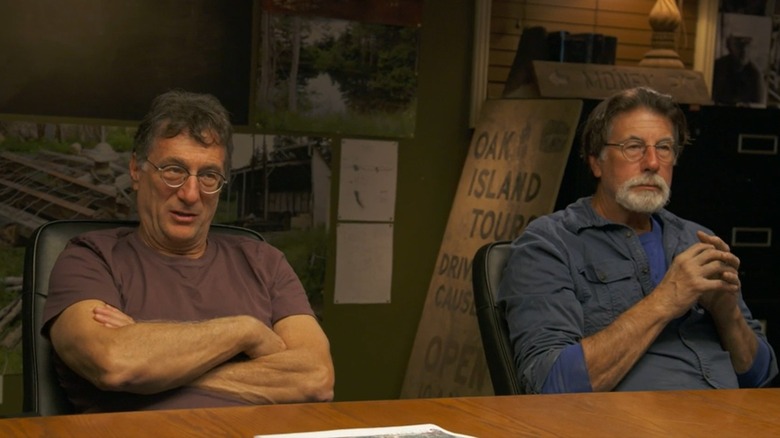A Curse Of Oak Island Clue May Have Derived From An Edgar Allan Poe Story
The hunt for treasure on a small island off the coast of Nova Scotia has allegedly claimed the lives of at least six people and hasn't turned up any significant finds — other than a few objects that have led to even more questions from explorers. Marty and Rick Lagina have been searching for the island's fabled "money pit" for over a decade, with The History Channel documenting their adventures on "The Curse of Oak Island." But that is just a proverbial drop in the bucket, with the first expeditions searching for the treasure beginning over 200 years ago. Commercial excavation of the area that is believed to entomb the treasure began at the beginning of the 19th century when The Onslow Company first made a real effort to follow up on some teenager's odd discovery of a timber floor to a shaft while digging on the island years earlier.
The company dug deep into the earth on the island and found several more of these timber floors at various depths in the hole that they dug, with each timber floor having a new material that added to the mystery of the island. At 30 feet, the laborers found a timber level with remnants of charcoal, and at 50 feet, another timber barrier with traces of coconut shells — but what they found at 90 feet would leave the explorers baffled for decades to come.
A stone slab was found with an odd inscription on it of characters that were of no known language — 40 symbols broken up into eight groupings. While the cipher was relatively short, it wasn't until the 1860s that a credible translation became available, thanks in part to a short story from Edgar Allan Poe.
Lessons from The Gold-Bug helped an academic provide an answer
The technique used to eventually decode the mysteriously engraved stone tablet found on Oak Island was taken directly from the pages of the Edgar Allan Poe short story "The Gold-Bug," a short story about a man who decodes a cryptogram that tells of buried treasure and takes his servant and friend along on the adventure. The main character deciphers a cryptic message using what is called "simple substitution cipher," which substitutes symbols for letters to uncover the message.
An 1860s academic, languages professor James Leitchi of Dalhousie University, is thought to have deciphered the stone slab found on Oak Island using the method that the protagonist used in Poe's story, concluding that the message read, "forty feet below, two million pounds are buried." The dig for the treasure was renewed after the slab was translated, but nothing was found 40 feet further down the shaft. Over the years, teams would eventually dig much further and still find no treasure, rather unlocking even more mysteries. Now it is up to the Lagina brothers to try to figure out what it all means and where the treasure is hidden — if it even exists at all.

